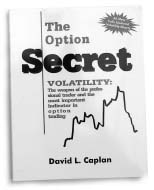.jpg)
Follow
Us:    
|
“Protecting Your Personal Assets”
provided by Guardian Law,
presented by Gregory Christiansen
Date: Thursday, July 7th
Time: 3:00PM PT / 4:00PM ET
Duration: 45 Minutes/15 Minute Q&A
You won’t want to miss this educational estate planning and entity protection training webinar with Gregory Christiansen, Owner of Guardian Law, who specializes in entity, tax and estate law.
Register Today!
You Will Learn:
-How to choose the best entity for trading activities or your business.
-Shielding liability, protecting your personal assets.
-Increased tax deductions and exemptions.
-How to lower your taxes through tax planning.
-Save money and reduce your tax obligation.
This is a FREE webinar, but SPACE IS LIMITED, so don't wait...
Register Now!

|
|
Dave Caplan founded and is former President of Opportunities in Options in Malibu, Calif., a firm that specializes in analyzing and identifying potential option trades with the best returns and the lowest risks. A pioneer in innovative option trading strategies, he is the author of several best-selling books including The Options Advantage, The Options Secret and Trade Options Like a Bookie.
 |
David L. Caplan’s
The Option Secret

This book is an indispensable tool for all option traders. Inside, renowned publisher, speaker and author Dave Caplan explains how to use volatility as a measure of under- and over-valuation on any option. This, according to Caplan, can put the odds of success (profitability) in your favor up to 90% of the time. Coupled with the limited risk inherent in options, that measurement of volatility is the true key to realizing consistent profits in options. Caplan explains it all, in clear and concise language, in the pages of this breakthrough book. And you can get a copy now at half the regular price. Supplies are limited, so order soon!
Learn More About
The #1 Option Trading Weapon
The Option Secret
|
|

Better
Business Bureau
 |
|
Click on authors name
to learn more
|
| |
|
|
Dave Caplan is our featured author this week. In his article, Dave covers two specific trading strategies.
Next, we hear from top-trader Lee Gettess on his market predictions for the coming week.
Then, Wendy Kirkland discusses how the strike price is used to help select weekly options.
Last, Chris Verhaegh shares his PULSE Options Weekly Newsletter.
Enjoy!
Adrienne LaVigne
TradeWins Publishing
 |
|
Specific Strategies: Raging Bull & Doomsdayer’s
by
Dave Caplan
The following is an excerpt from Dave Caplan's The Option Secret
Let me dive right in and begin with “Raging Bull Strategies”. You think the market is grossly oversold – poised for a major move higher.
Let’s use silver as an example. Your analysis indicates that it is about to make a move from the $3.50 level to over $5.50. Your best estimate calls for $6.00 silver within the next 60 days.
The simplest and most common approach for a new investor is to buy a call. The call gives you the right, but not the obligation, to take a long position in the underlying futures. As the underlying futures gains, so does the call. You can either exercise the option and take your long futures position, or you can offset your option positions at a profit as it gains intrinsic value.
The more difficult question is which strike price to buy. Below is a table showing your choices for calls with 60 days to expiration on 5,000 troy ounces of silver.
Raging Bull & Doomsdayer’s
|
Lee
Gettess' Market Sense
by Lee Gettess
Lee
Gettess is a top trader who is excited
to bring you his video newsletter.
Each week, Lee will share his predictions
on what he anticipates from the bond
and S&P markets.
Watch
Video
|
Weekly Options: The Strike Price
by Wendy Kirkland
The following
is an excerpt from Wendy Kirkland's Wealth Building with Weekly Options
The weekly option that we select for the weekly strategy should be at or slightly out-of-the-money. The agreed upon price at which the option can be exercised is the strike price; therefore, that price is a factor in the selection.
Let’s say you want to purchase a put option to sell Deere (DE). It’s current price is $79.34 a share. You can agree to sell shares of DE stock for $80 or you can agree to sell DE stock for $85. If both options cost the same which one would you choose to sell? The options with the $85 exercise or strike price. That’s a no-brainer.
Now let’s assume DE decreases in value to $75. If you had the right to sell the stock for $85, you could “exercise” your right, purchase the stock for $75, and then sell it for the strike price of $85, thus earning a profit of $10 per share or $1,000 for your 100 share option contract. Needless to say, you would not “exercise” your right to buy, if you owned the option with a $72.50 strike price. You would choose to do nothing because there would be no profit in it, and no reason to pay the fee to close the trade.
The Strike Price
|
PULSE Options Weekly Newsletter
by Chris Verhaegh
The following is an excerpt from Chris Verhaegh’s PULSE Options Weekly Newsletter
Every week Chris Verhaegh publishes his “PULSE Options Weekly Newsletter”. The following is an excerpt from his most recent issue.
Market Wide Reports to be Released
The Federal Reserve (the “Fed”) releases the Meeting Minutes from their two-day FOMC Meeting (held in June) today, Wednesday (7/6). Typically the market remains somewhat flat until the actual release. But maybe some insight contained in the Minutes will cause the market to move further?
Thursday is the day between two major Government releases. And while it’s possible for the market to continue higher at this point in time, if the trend does continue this long, I would certainly buy Put options anticipating some exhaustion and an eventual reversal.
Then, Friday morning the Bureau of Labor Statistics releases the monthly Non-Farm Payroll (NFP) report. Since the “Jobs” number, as the NFP is often called, comes out one hour before the market opens; we should know before trading starts if we should expect a higher or lower open.
Last week was crazy volatile, all to the upside. If this upcoming week is crazy volatile, it should be in both directions!
To Learn More Click Here
|
|